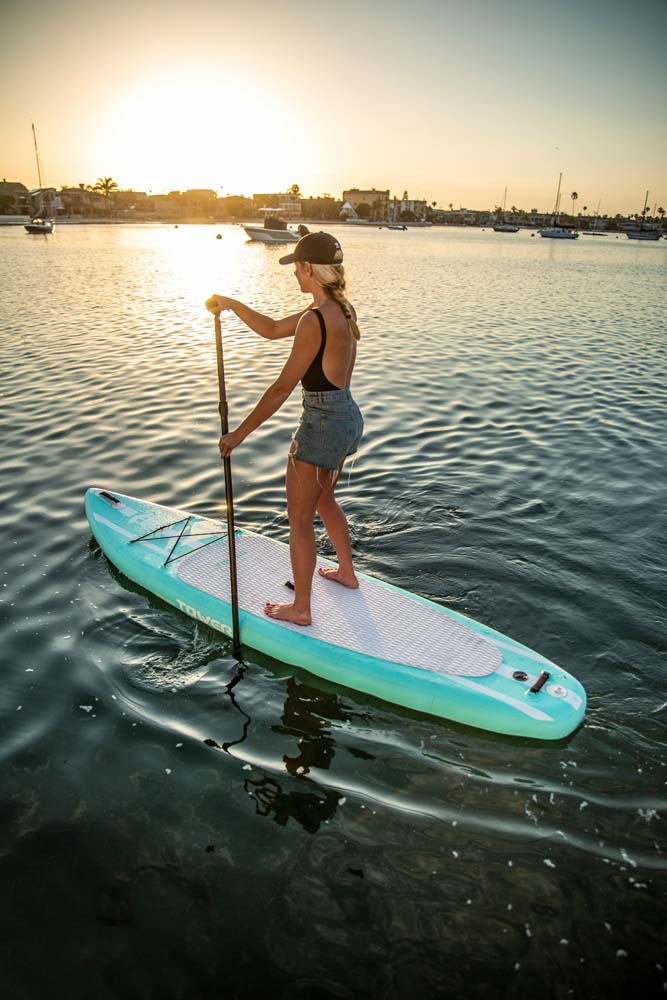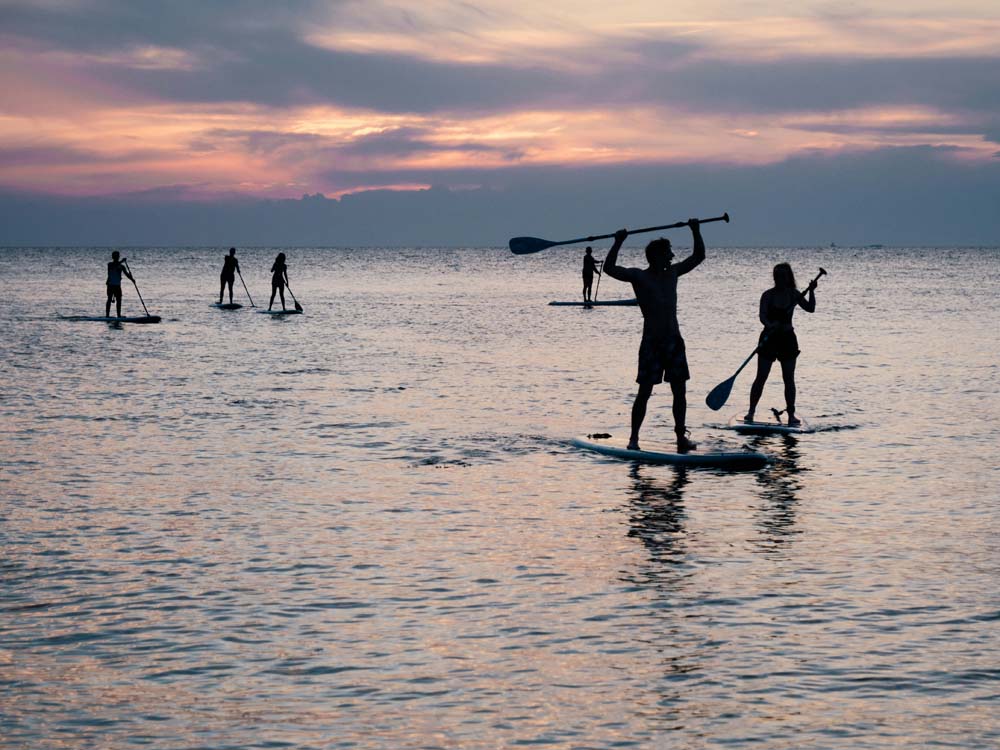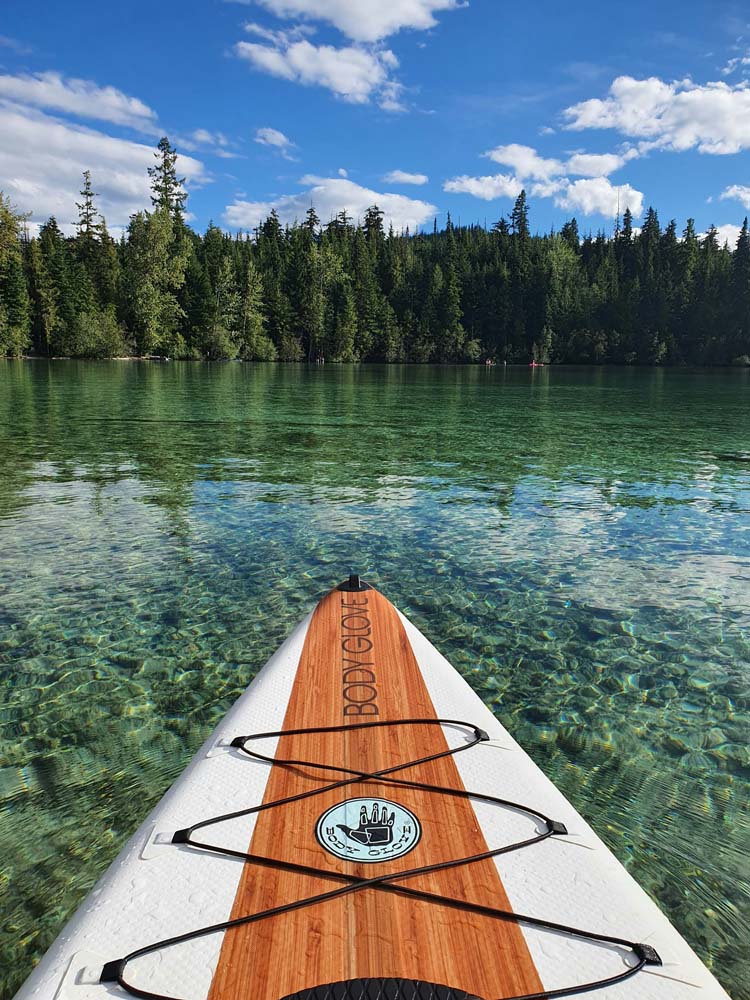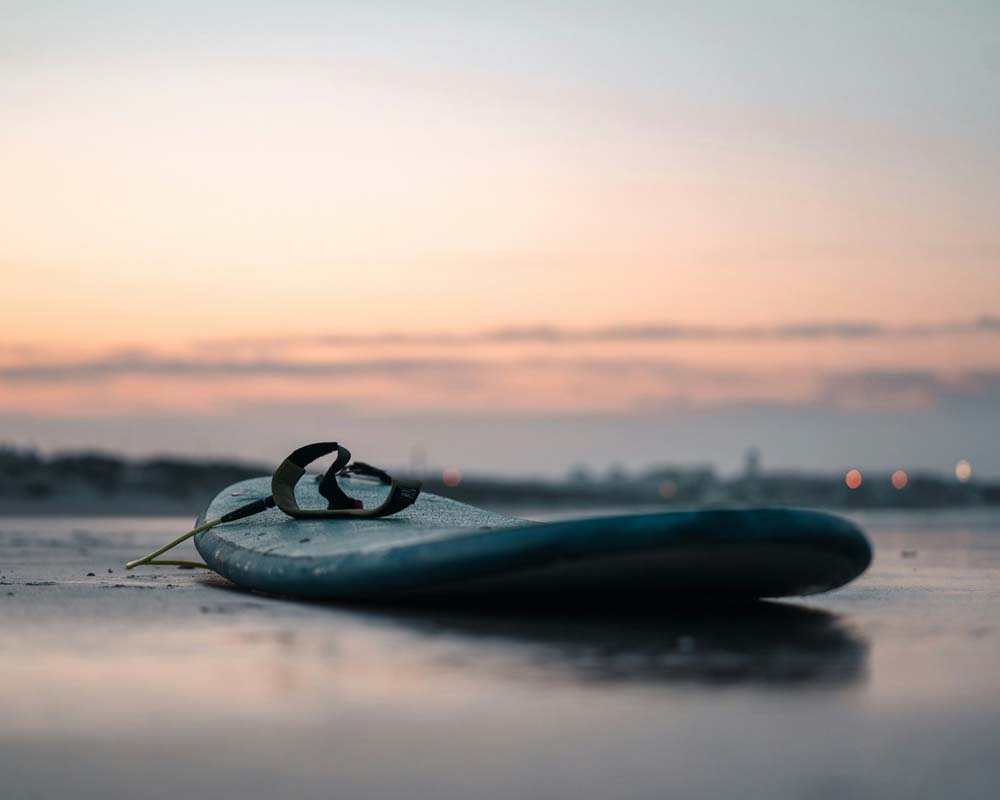Ever watched someone glide effortlessly across the water on a stand-up paddle board and thought,
“That looks fun, but isn’t paddle boarding hard?”
If so, you’re not alone!
The world of SUP (that’s stand-up paddle boarding for the uninitiated) can seem a bit intimidating at first. However, it’s fun once you get the hang of it.
But fear not, fellow water sport enthusiasts – we’re here to break it down for you in a way that’s as easy to learn as a paddle stroke on flat water.
Imagine this: you’re out on a serene lake, the water as smooth as glass, and there you are, standing tall on your paddle board like a pro. S
ounds dreamy, right?
Well, it’s more achievable than you might think, especially when you’re paddling on calm water. While it’s true that you might start off kneeling, with your knees slightly bent and your paddle in hand, you’ll soon find your balance improving with each paddle stroke.
For beginners, the idea of going from a kneeling position to a full-standing position might seem a bit daunting.
But trust me, it’s all about getting the hang of it.
The key is to keep your feet shoulder width apart and your knees slightly bent for better balance and paddle efficiency. This isn’t difficult if you follow these tips. And remember, an inflatable paddle board can be a great starting point – it’s stable and forgiving, perfect for those early wobbles.
Sure, you might have a few ungraceful moments and maybe even a splash or two, but isn’t that part of the fun?
Before you know it, you’ll be paddling along with ease, your leash securely fastened, and your confidence soaring higher with each paddle stroke.
No matter where you are, you’ll find that paddleboarding isn’t as hard to learn as it seems. In fact, it’s downright exhilarating.
This water sport is so chill, I am sure you’re gonna love it once you master the basics!
So, grab your board and paddle, maybe even your surfboard for some extra fun, and let’s dive into the world of SUP.
Paddle boarding is easier to learn than you think, and way more fun than you ever imagined. It’s a great way to enjoy the water. Ready to improve your balance and master the right paddle technique? Let’s get started!
Is Paddle Boarding Hard to Learn?

So, you’re standing on the shore, paddle in hand, staring at your shiny new paddle board.
The first question that comes to mind is obviously :
“Is paddle boarding hard to learn?”
Let’s set the record straight: if you can walk and chew gum at the same time, you can learn to paddle board.
Seriously. Paddle around and enjoy the benefits of paddle boarding.
Statistics tell us that about 70% of beginners manage to stand up and paddle away on their first try.
The other 30%?
Well, they just get a little extra time to enjoy the water up close and personal.
And trust me, those initial splashes are all part of the adventure!
Getting Started: From Kneeling to Standing
First things first: don’t worry about looking like an expert paddle boarder right out of the gate.
- Start in a kneeling position with your knees slightly bent and your feet shoulder width apart. This position helps you get a feel for the board and your paddle strokes. Your paddle should be at the right length – think Goldilocks, not too long, not too short, but just right.
- Once you’ve gotten the hang of kneeling, it’s time to stand up. People of all ages can enjoy stand up paddle boarding. Here’s a fun fact: stand-up paddle boarding actually originated as a way for surf instructors to manage their classes on the water. So, if those surf instructors could master it, so can you.
- From your kneeling position, move one foot at a time to where your knees were. Keep your knees slightly bent, and before you know it, you’ll be in a standing position, gliding along like a natural.
That’s it! In 3 easy steps you are already up on your board!
Balance: Your New Best Friend
Improving your balance is key, and luckily, the learning curve is pretty gentle. On flat water, an inflatable paddle board is as stable as it gets.
And if you fall, remember: the water’s there to catch you.
Paddleboarding is a fantastic way to work out those stabilizer muscles you never knew you had, all while soaking up the sun.
Mastering the Paddle Stroke
- The paddle stroke might look complicated, but it’s as easy as pie once you get the hang of it.
- Grip your paddle with one hand on the top and the other about halfway down the shaft.
- Dip the paddle into the water in front of you and pull it back in a smooth motion.
Voila!
You’re paddleboarding!
Remember, the key is smooth, steady strokes, not frantic splashing. Think graceful swan, not flailing duck.
At the beginning, you might risk putting the paddle the wrong way, but it’s not a big deal.
The Joy of Progress
One of the best parts about paddleboarding is seeing how quickly you improve.
Every time you get back on that board and paddle out, you’ll notice you’re a little steadier, a little more confident. SUP paddle helps you achieve this feeling. Plus, the sense of accomplishment you get when you paddle farther or stay up longer than before is unbeatable.
So, is paddle boarding hard to learn?
Not at all.
With a bit of practice, a lot of laughs, and a few inevitable splashes, you’ll be cruising the waterways like a seasoned paddle boarder in no time.
What makes SUP an easy sport to learn?

Now that we’ve debunked the myth of paddle boarding being hard to learn, let’s dive into what makes stand-up paddle boarding (SUP) such an easy and accessible sport for everyone, from beginners to seasoned water enthusiasts.
1. Minimal Equipment Required
Unlike some other water sports that require a truckload of gear, SUP keeps it simple. All you need is a paddle board, a paddle, and a leash. Oh, and don’t forget your sense of adventure! There are inflatable paddle boards that make transport a breeze – just pump it up, and you’re good to go. This simplicity means you can spend more time enjoying the water and less time fussing with equipment onto the board.
2. Gentle Learning Curve
One of the beauties of SUP is that it is easy to learn. Start on flat water where there are minimal waves and currents. This stable environment helps you get comfortable with balancing on the board and mastering your paddle strokes.
According to a survey, over 85% of beginners reported feeling confident on their boards after just a few sessions. And remember, falling off is part of the learning process – each splash is a step closer to mastery!
3. Accessible for All Ages and Fitness Levels
Whether you’re 8 or 80, SUP welcomes all ages and fitness levels. You don’t need to be a super athlete to enjoy paddleboarding. The basic movements are straightforward and low-impact, making it a fantastic activity for families, fitness newbies, and even those looking for a gentle way to stay active. Plus, it’s a fantastic full-body workout that doesn’t feel like exercise – you’ll be toning muscles and improving balance without even realizing it!
4. Great for Building Balance and Core Strength
SUP is an excellent way to improve your balance and core strength. As you paddle along, your body engages all those stabilizer muscles, especially your core. With your feet shoulder width apart and knees slightly bent, you’ll find yourself getting a fantastic workout that’s as fun as it is effective. And the best part? You’re out in nature, enjoying the great outdoors, instead of being stuck in a gym.
5. Versatility in Water Conditions
Whether you’re on a calm lake, a slow-moving river, or a gentle ocean bay, SUP adapts to various water conditions. For beginners, starting on flat water is ideal. As you gain confidence and skill, you can venture into different environments and even try surfing small waves. The versatility of SUP means you can always find new challenges and ways to enjoy your paddle board.
6. Community and Support
The SUP community is incredibly welcoming and supportive. From local meet-ups to online forums, you’ll find plenty of fellow paddle boarders eager to share tips, advice, and encouragement. Many areas also offer beginner classes where you can learn the basics in a supportive environment. Being part of a community can make the learning process more enjoyable and less intimidating.
7. Immediate Rewards
One of the best things about SUP is the immediate sense of accomplishment. From your first successful stand to your first smooth paddle stroke, every milestone feels rewarding. And the best part? You get to enjoy stunning views and the calming presence of water while you’re at it. It’s a win-win for both body and soul.
Do You Need Lessons To Paddle Board?
Great question! The short answer is: not necessarily, but they sure can help!
For many beginners, SUP is intuitive enough to pick up on your own, especially if you start on calm, flat water. Watching a few instructional videos or reading a beginner’s guide can be enough to get you standing and paddling.
However, taking a lesson can accelerate your learning curve and boost your confidence. You’ll want to make sure you’re learning the right techniques. A good instructor can teach you the basics of paddle strokes, standing position, balance tips, and how to handle your board and paddle. Plus, they’ll ensure you’re using the right paddle and help you understand the importance of your leash for safety.
Lessons are especially beneficial if you’re feeling a bit nervous or if you plan to paddle in more challenging conditions, like waves or currents. They can also be a fun way to meet other beginners and join the local paddleboarding community.
So, while you don’t need lessons to start paddleboarding, they can definitely make your experience smoother and more enjoyable. Whether you go solo or with a pro, the key is to get out there and start paddling.
Start With The Right Type Of Board

Choosing the right paddle board is like finding the perfect pair of shoes – it makes all the difference! As a beginner, you’ll want a board that offers stability and ease of use. Here’s a quick guide to help you make the best choice without spending too much time deliberating:
1. Size and Stability
For beginners, wider and longer boards are your best friends. A board that is at least 32 inches wide provides excellent stability, making it easier to keep your balance. Longer boards (10-12 feet) also offer more stability and a smoother ride, perfect for flat water.
2. Inflatable vs. Hard Boards
Inflatable paddle boards are fantastic for newbies. They’re durable, easy to transport, and surprisingly stable. You can deflate and pack them in a backpack, making them ideal for those short on storage space or who plan to travel with their board. Hard boards, often made of fiberglass or epoxy, offer a slightly better performance and speed, but they’re bulkier and less forgiving of bumps and scrapes.
3. Board Volume and Weight Capacity
Make sure to check the board’s volume and weight capacity. The volume (measured in liters) indicates the board’s ability to float with weight on it. Beginners should look for a board with a higher volume, ensuring it can support your weight comfortably and provide extra stability.
4. All-Around Boards
All-around boards are perfect for beginners. Stand up paddle boarding might be the easy water sport you are looking for. They are versatile, stable, and suitable for a variety of water conditions, from flatwater lakes to gentle ocean waves. As you get more experienced, you can explore specialized boards like touring or racing models, but an all-around board is a great place to start.
5. Soft-Top Boards
Soft-top boards are another excellent option for beginners. They have a cushioned deck that’s more comfortable for kneeling and standing, and they’re generally more durable against dings and scratches. This type of board can make your initial paddling experience more enjoyable and forgiving.
If you want to make sure you pick the right paddle board for you, make sure to read this article that will really help you decide : How To Choose The Right Stand Up Paddle Board
Beginner paddle boarding tips
Ready to hit the water and start your paddle boarding adventure?
Here are some essential tips to help you get started on the right foot (or paddle)!
Get Comfortable Balancing on Your Board
- Start on Flat Water to maintain better balance and paddle more effectively: Begin your paddle boarding journey on calm, flat water. This type of water condition provides the most stability and makes it easier to get the hang of balancing on your board.
- Use a Wide, Stable Board: Choose a board that is at least 32 inches wide. A wider board offers more stability, making it easier for you to find your balance and feel secure.
- Begin in a Kneeling Position: Start by kneeling on the board to get a feel for it. Position your knees slightly apart and find your balance before attempting to stand up. This will help you gain confidence and understand how the board responds to your movements.
- Stand Up Slowly: When you’re ready to stand, move one foot at a time to the spot where your knees were. Keep your knees slightly bent, feet shoulder width apart, and your gaze forward. Standing up gradually helps maintain your balance and reduces the risk of falling.
- Keep Your Knees Bent: Keeping your knees slightly bent acts as a natural shock absorber and helps maintain stability. It allows you to adjust to small waves or movements in the water without losing your balance.
- Use Your Core: Engage your core muscles to help stabilize your body. Your core plays a crucial role in maintaining balance and controlling your movements on the board.
Personal tip : if you feel like it is too much to manage at the same time, your board and your paddle, just get in the water, get on the board, sit on it, try to get on your knees, test the board’s balance, and that’s it for the first day. Just get to know your board, its limits, volume. If you feel like it, try to stand up slowly. Just make sure you don’t look at your feet. Where you look will help you stand up. So look far.
The next day, your body has already integrated some sense of balance on the board, so now, you are ready to get on the board with your paddle and get the board moving.
Paddling Techniques
Mastering the basic paddling techniques will make your paddle boarding experience more enjoyable and efficient. Here are some tips to get you started:
- Grip the Paddle Correctly: Hold the paddle with one hand on the top handle and the other hand about halfway down the shaft. This grip gives you better control and leverage for each stroke.
- Proper Paddle Length: Make sure your paddle is the right length. When standing the paddle vertically next to you, the top of the paddle handle should reach your wrist. This ensures you have the correct reach and leverage for effective paddling.
- Paddle with Smooth, Steady Strokes: Dip the paddle blade into the water about two feet in front of you and pull it back in a smooth, steady motion. Avoid frantic paddling – smooth strokes help you move efficiently and maintain balance.
- Switch Sides Regularly: To keep moving straight and maintain a good rhythm, switch the paddle from one side to the other every few strokes. This helps balance your efforts and keeps you on course.
- Use Your Core and Shoulders: Rather than relying solely on your arms, use your core and shoulders to power your paddle strokes. This not only makes your paddling more efficient but also provides a better workout. It’s a great way to stay fit.
- Look Where You’re Going: Keep your eyes on the horizon or where you’re heading, rather than looking down at your feet. This helps maintain your balance and direction.
By following these beginner tips and practicing your paddling techniques, you’ll quickly become comfortable and confident on your paddle board. So, grab your board, hit the water, and enjoy the ride!
If you don’t know what paddle to choose make sure to read : How To Choose A Paddle Paddle Board



0 Comments